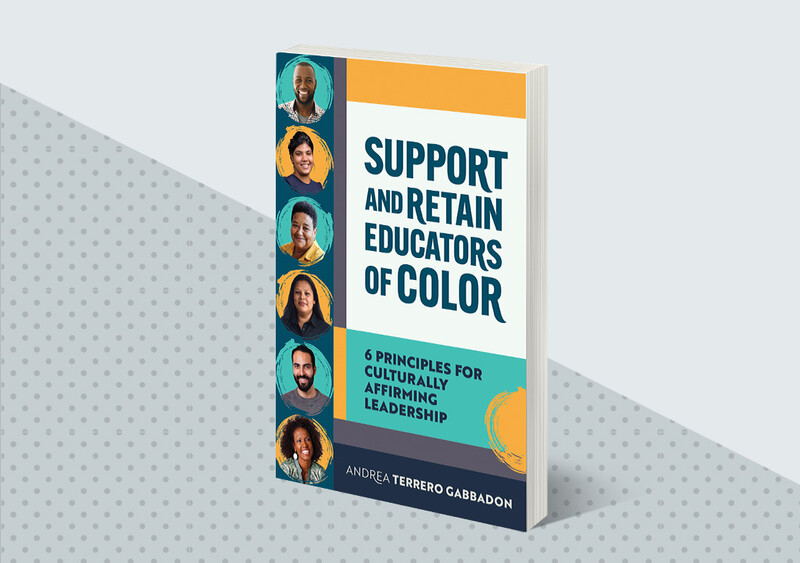Bias—it’s a loaded term. It has an enormous effect on students, resulting in exclusionary discipline, low expectations, disproportionate referrals for gifted and special education programs, and tracking, all of which harm students’ learning opportunities and perceptions of their potential (Grinage, 2023). Seminal theorists such as Gloria Ladson-Billings (2022) highlight how educators’ unconscious beliefs shape their daily practices, influencing students’ academic outcomes, self-perceptions, and visions of their future.
But there’s also a less explored, equally important reality about bias: how it permeates the experiences of teachers, particularly teachers of color. Bias doesn’t just affect working conditions; it also acts as a gatekeeper in school and district recruitment and hiring practices, creating barriers that shape who gets to teach.
Challenging Assumptions
Studies consistently demonstrate that teachers of color positively affect both the academic and nonacademic outcomes of students. Benefits include higher expectations that lead to increased student learning and engagement, lower rates of absenteeism, reduced dropout rates, increased graduation rates, and higher rates of college entry and persistence (Bristol & Martin-Fernandez, 2019; Villegas & Irvine, 2010). However, despite these well-documented outcomes, the educator workforce remains predominantly white and female.
In 1998, former U.S. Secretary of Education Richard Riley declared, “If we are to be responsive to the special demands and great opportunities of our nation’s pluralistic makeup, we should develop a teaching force that is diverse, as well” (p. 19). Yet over 25 years later, the United States has made little progress in closing the ethnoracial representation gap between teachers and students. Although more teachers of color are entering the field than in previous decades, they still only represent about 20 percent of the educator workforce (National Center for Education Statistics, 2020). Teachers of color are more often found in schools with higher percentages of students of color (NCES, 2020) and students who come from households with lower income levels (Schaeffer, 2021). Principals of color are more likely to hire teachers of color and retain them at higher rates (Bartanen & Grissom, 2019).
Bias can lead us to put undue value on what is familiar or similar to ourselves or on what we’re conditioned to perceive as most effective.
We need to challenge conventional assumptions about the availability of effective and diverse teacher candidates. Instead of asking, “Where are all the applicants of color?”, district and school leaders need to ask themselves, “How is bias keeping us from accessing a more diverse applicant pool?”
Defining the Terms
Bias reflects our implicit social and cultural conditioning, causing us to think and act in ways that may contradict our stated beliefs. This is important to understand in a society where cultural racism functions like an ever-present smog (Tatum, 2003), spreading distorted messages about people of color that overshadow their cultural genius, joy, and tradition of teaching excellence (Muhammad, 2020). Even those committed to anti-bias, inclusion, and equity are not immune to this smog, and they must work continuously to align their unconscious beliefs with their expressed ideals.
Systemic bias, on the other hand, is defined as follows by Oxford Reference (n.d.):
The tendency for the procedures and practices of particular institutions to operate in ways which result in certain social groups being advantaged or favored and others being disadvantaged or devalued. This need not be the result of any conscious prejudice or discrimination but rather of the majority simply following existing rules or norms.
In the context of recruitment and hiring, systemic bias can show up in an overemphasis on cultural fit over qualifications, favoring candidates from certain backgrounds and certain pedagogical approaches, as well as in a lack of respect for culturally responsive teaching strategies that many educators of color are drawn to using (Achinstein & Ogawa, 2012). Systemic bias is more harmful than name bias (negative associations and prejudice on the basis of names); affinity bias or “mini-me syndrome” (a preference for those who share common traits); or confirmation bias (the tendency to search for and consume information that upholds prior beliefs and values while dismissing alternative truths). Systemic bias can be deeply ingrained in a school’s ecosystem, shaping organizational norms and perpetuating inequities in ways that go unnoticed.
Mitigating Bias in Recruitment and Hiring
Because education leaders play a pivotal role in hiring practices and set the tone for organizational culture, they’re well positioned to monitor their systems for systemic bias. Here are some ways to do this.
Audit Current Practices
Start by gathering data on the channels used to attract potential candidates. This can help you determine if you’re casting a wide enough net. Examine the demographic profiles of candidates, including those who began but who did not complete applications, as well as those who completed applications and participated in interviews. Are certain candidate groups disproportionately dropping out at specific stages? Are certain recruitment channels yielding more diverse applicants than others? Look for the overrepresentation of certain groups; the underrepresentation of minoritized educators, such as multilingual educators or graduates from alternative teacher preparation programs; or sourcing inequities that inadvertently reinforce homogeneity within staff.
Recruitment efforts must be integrated with robust support systems and clear pathways for professional growth that celebrate and sustain teachers of color.
Examine job descriptions for language that might discourage diverse candidates. Is there an overemphasis on cultural fit or a preference for alumni from a given institution? Does the description stipulate a certain number of required years of teaching or a “preference for candidates from a traditional teaching background”? This would exclude career changers or graduates from alternative teacher-education programs. Gendered phrases such as “He/She will manage classroom activities effectively” exclude those who don’t identify with the gender binary. Finally, references to personal characteristics—such as “an articulate and polished professional demeanor is required”—demonstrate a unilateral meaning of what constitutes “professional” and often exclude first-generation college graduates and applicants from nondominant racial or linguistic backgrounds.
Instead, use inclusive and welcoming phrases like these:
“We’re looking for candidates who possess strong communication skills and the ability to connect with diverse student populations.”
“We value a variety of experiences and backgrounds in education or related fields.”
“We’re looking for educators who bring diverse perspectives and enrich our school culture.”
“We’re committed to building a team that reflects the diversity of our students and community.”
Partner with an external consultant, district leaders, community members, or teachers—especially teachers of color—to revise language that may be biased or exclusionary. Seek their input to ensure that job descriptions are not only inclusive but also welcoming to racially diverse candidates.
Set Recruitment and Hiring Goals
Set clear goals to promote hiring equity and establish a process for progress monitoring. For instance, if the initial audit reveals fewer than 10 percent of applicants are educators of color, create a benchmark of 20 percent over the next hiring cycle by expanding recruitment channels. Instead of leaving diversity efforts to the central office or human resources department, district leaders and principals should take ownership for making progress toward recruitment goals. When possible, create a selection committee of wide-ranging voices that offer fresh insights and understand the value of diverse staff. Share hiring data trends and goals with community stakeholders to foster transparency and maintain accountability in achieving these aspirations.
Expand Recruitment Pipelines
According to neuroscientists and executive coaches Heidi Grant Halvorson and David Rock (2015), bias leads us to put undue value on what is familiar or similar to ourselves or on what we’re conditioned to perceive as most effective. In hiring and recruitment, this can manifest as conscious or unconscious preferences about where the “best” applicants are found. This bias is particularly evident in school-university partnerships, where colleges of education are commonly used as teacher pipelines—especially when school leaders are alumni of those institutions.
I experienced this firsthand. As a building leader responsible for staffing, I often favored applicants from my alma mater 10 miles away, overlooking the high-quality teacher preparation program at a nearby Hispanic-serving institution only 5 miles away. This unexamined bias inadvertently limited the breadth of the candidate pool I considered.
Are you aware of the minority-serving institutions near your districts and schools? Have you considered partnering with historically Black colleges and universities, tribal colleges and universities, or Hispanic-serving institutions? These produce a large share of teacher candidates of color (Akua et al., 2021), so establishing mutually beneficial partnerships with them can expand your recruitment pipelines and welcome their graduates to apply to your school or district.
If such institutions are not accessible in your area, consider developing partnerships with equity-focused educator organizations, such as Profound Gentlemen (which supports male educators of color); the Pennsylvania Educator Diversity Consortium; BMEs Talk (a learning community for Black male educators); Latinos for Education; or the Center for Black Educator Development. Collaborating with these organizations not only helps diversify your candidate pool, but also offers additional benefits, such as mentorship, coaching, and affinity groups to support teachers of color.
It’s also important to ensure that applicants feel welcome during the recruitment process. Desiree Carver-Thomas (2018) explores how high-touch recruitment methods, such as relationship-building and application support, can help engage prospective candidates of color. Districts may consider adopting similar strategies, such as providing virtual or in-person application workshops where candidates can receive personalized support or a step-by-step video guide with subtitles that explains the application process and hiring timeline.
Finally, tap into the knowledge of your current staff. They may have personal connections or innovative ideas for diversifying your candidate pool. Expanding your outreach and adding a personal touch require intention, but the rewards are worth the effort.
Implement Protocols
Using standardized protocols, such as checklists and rubrics, can help school leaders equitably assess a candidate’s potential by raising awareness about potential bias and about the halo/horns effect, which entails overemphasizing one positive quality (halo) or one negative quality (horns) of an applicant to the detriment of other equally important elements.
Using standardized protocols, such as checklists and rubrics, can help school leaders equitably assess a candidate’s potential.
Standardized screening protocols—such as the hiring tool from EquityToolkit.org—are available online to use as starting points. Ideally, such tools should include (1) clear and specific criteria, such as education and teaching credentials; (2) criterion-based weights so that qualifications such as experience teaching diverse learners weigh more than years of experience; and (3) a clear scoring guide. For example, in Valley Stream 13 School District on Long Island, standardized protocols ensure that application reviewers don’t exclude candidates on the basis of arbitrary measures like grade point average, years of experience, or number of certifications. Instead, application reviewers look for evidence of important noncognitive skills and cultural humility (The Education Trust, 2019). Mitigate Bias in Interviews
Your hiring panel should be diverse and should include leaders, managers, teachers, and even students. There should be an explicit commitment to ensure that all voices are welcome during the interview and when evaluating the applicant. Interviewers should use a structured interview protocol with vetted questions to reduce the opportunity for bias and inconsistency. The Equity Toolkit offers a wide range of sample interview questions, as well as an aligned rubric with criterion-based weights. Be sure to train panel members on how to recognize and counter different forms of bias and what to do when they emerge.
Where to Go from Here?
Recruitment efforts must go beyond simply bringing effective candidates through the door. The fact is, many educators of color ultimately leave their schools as a result of hostile racial climates, performance pressures, and role entrapment (Gabbadon, 2023; Kohli, 2018). Recruitment efforts must be integrated with robust support systems and clear pathways for professional growth that celebrate and sustain teachers of color.
The work begins with a pivotal question: How can we design recruitment practices that not only bring diverse educators into our schools, but also sustain their brilliance, amplify their voices, and honor their humanity? By addressing this question—and committing to the inner and organizational work required to identify and dismantle systemic bias—we can take meaningful steps toward closing the representation gap between teachers and students.
Reflect & Discuss
➛ Do you tend to rely on familiar or convenient pipelines in teacher recruitment? How might you branch out to new options?
➛ What steps could your district take to improve relationship-building with diverse teaching candidates?
Support and Retain Educators of Color
Andrea Terrero Gabbadon presents six principles to guide school leaders in their efforts to support and retain educators of color.










